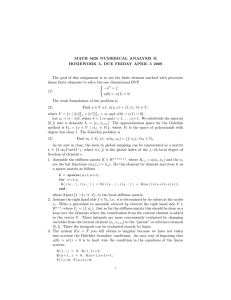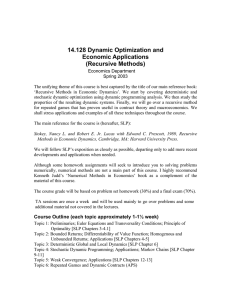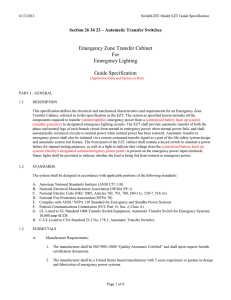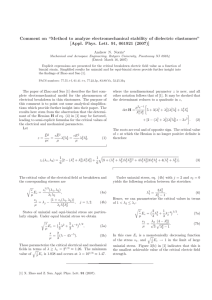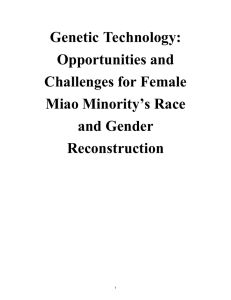SUPPLEMENT TO “AMBIGUITY, LEARNING, AND ASSET RETURNS”: TECHNICAL APPENDIX Econometrica B
advertisement
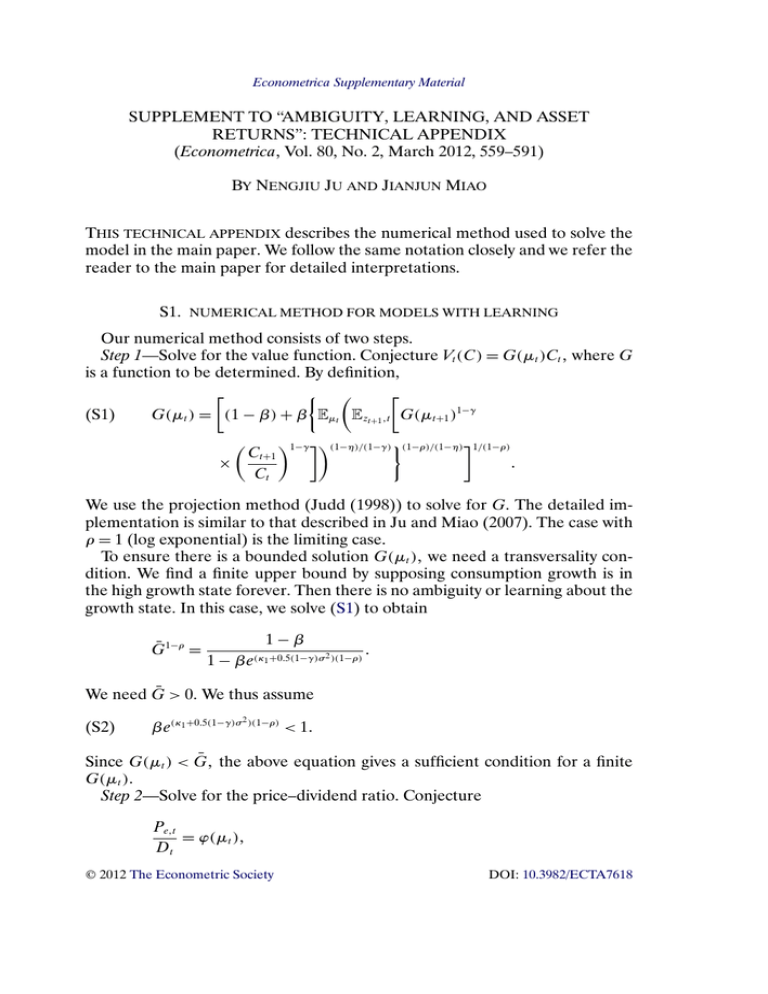
Econometrica Supplementary Material SUPPLEMENT TO “AMBIGUITY, LEARNING, AND ASSET RETURNS”: TECHNICAL APPENDIX (Econometrica, Vol. 80, No. 2, March 2012, 559–591) BY NENGJIU JU AND JIANJUN MIAO THIS TECHNICAL APPENDIX describes the numerical method used to solve the model in the main paper. We follow the same notation closely and we refer the reader to the main paper for detailed interpretations. S1. NUMERICAL METHOD FOR MODELS WITH LEARNING Our numerical method consists of two steps. Step 1—Solve for the value function. Conjecture Vt (C) = G(μt )Ct where G is a function to be determined. By definition, (S1) G(μt ) = (1 − β) + β Eμt Ezt+1 t G(μt+1 )1−γ Ct+1 × Ct 1−γ (1−η)/(1−γ) (1−ρ)/(1−η) 1/(1−ρ) We use the projection method (Judd (1998)) to solve for G The detailed implementation is similar to that described in Ju and Miao (2007). The case with ρ = 1 (log exponential) is the limiting case. To ensure there is a bounded solution G(μt ) we need a transversality condition. We find a finite upper bound by supposing consumption growth is in the high growth state forever. Then there is no ambiguity or learning about the growth state. In this case, we solve (S1) to obtain Ḡ1−ρ = 1−β 1 − βe (κ1 +05(1−γ)σ 2 )(1−ρ) We need Ḡ > 0. We thus assume (S2) βe(κ1 +05(1−γ)σ 2 )(1−ρ) < 1 Since G(μt ) < Ḡ the above equation gives a sufficient condition for a finite G(μt ) Step 2—Solve for the price–dividend ratio. Conjecture Pet = ϕ(μt ) Dt © 2012 The Econometric Society DOI: 10.3982/ECTA7618 2 N. JU AND J. MIAO where ϕ is a function to be determined. We substitute the return equation Ret+1 = Pet+1 + Dt+1 ϕ(μt+1 ) + 1 Dt+1 = Pet ϕ(μt ) Dt into the Euler equation to derive ρ−γ −ρ Ct+1 Vt+1 1 = Et β (S3) Ct Rt (Vt+1 ) 1−γ −(η−γ)/(1−γ) ]) (Ezt+1 t [Vt+1 ϕ(μt+1 ) + 1 Dt+1 × [Rt (Vt+1 )]−(η−γ) ϕ(μt ) Dt We use Vt = G(μt )Ct to derive ρ−γ 1−γ −(η−γ)/(1−γ) (Ezt+1 t [Vt+1 ]) Vt+1 Rt (Vt+1 ) [Rt (Vt+1 )]−(η−γ) ⎞ρ−γ ⎛ Ct+1 ) G(μ t+1 ⎟ ⎜ Ct ⎟ =⎜ ⎝ Ct+1 ⎠ Rt G(μt+1 ) Ct 1−γ −(η−γ)/(1−γ) Ct+1 Ezt+1 t G(μt+1 ) Ct × −(η−γ) Ct+1 Rt G(μt+1 ) Ct We substitute this equation into (S3) and then use the projection method to solve for ϕ after we obtain the approximate solution for G in Step 1. We can similarly solve for the price–consumption ratio. S2. NUMERICAL METHOD FOR BENCHMARK MODEL I In the paper, we also solve a benchmark model with Epstein–Zin preferences under full information. We write the utility function as 1−ρ 1/(1−ρ) Vt (C) = (1 − β)Ct1−ρ + β Rt (Vt+1 (C)) (S4) 1/(1−γ) 1−γ (S5) Rt (Vt+1 (C)) = Et [Vt+1 (C)] Step 1. We conjecture the value function takes the form V (z) = G(z)Ct for z = 1 2. The function G satisfies 1−γ (1−ρ)/(1−γ) 1/(1−ρ) 1−γ Ct+1 (S6) G(z) = (1 − β) + β Ez G(z ) Ct 3 AMBIGUITY, LEARNING, AND ASSET RETURNS That is, (S7) G(1)1−ρ = (1 − β) + β λ11 G(1)1−γ exp((1 − γ)κ1 + 05(1 − γ)2 σ 2 ) + (1 − λ11 )G(2)1−γ (1−ρ)/(1−γ) × exp((1 − γ)κ2 + 05(1 − γ)2 σ 2 ) (S8) G(2)1−ρ = (1 − β) + β (1 − λ22 )G(1)1−γ exp((1 − γ)κ1 + 05(1 − γ)2 σ 2 ) (1−ρ)/(1−γ) + λ22 G(2)1−γ exp((1 − γ)κ2 + 05(1 − γ)2 σ 2 ) We can solve this system of nonlinear equations for two unknowns G(1) and G(2) We also need a transversality condition (S2). Step 2. Given the solution for G(z) in Step 1, solve the price–dividend ratio. Conjecture Pet = ϕ(zt ) Dt where ϕ is a function to be determined. We substitute the return equation Ret+1 = Pet+1 + Dt+1 ϕ(zt+1 ) + 1 Dt+1 = Pet ϕ(zt ) Dt into the Euler equation to derive −ρ ρ−γ Ct+1 Vt+1 ϕ(zt+1 ) + 1 Dt+1 1 = Et β (S9) Ct Rt (Vt+1 ) ϕ(zt ) Dt The above equation gives a system of two linear equations for two unknowns ϕ(1) and ϕ(2). We check solutions such that ϕ(1) > 0 and ϕ(2) > 0 Dept. of Finance, Hong Kong University of Science and Technology, Clear Water Bay, Kowloon, Hong Kong and SAIF, Shanghai Jiaotong University, China; nengjiu@ust.hk and Dept. of Economics, Boston University, 270 Bay State Road, Boston MA 02215, U.S.A. and CEMA, Central University of Finance and Economics and AFR, Zhejiang University, China; miaoj@bu.edu. Manuscript received December, 2007; final revision received June, 2011.
![SUNSPOTS: mt − pt = a − b[Ep t+1 − pt] Let zt = mt − pt. Then zt = mt](http://s2.studylib.net/store/data/018349753_1-c13b0b48398dd1be389310c631e0f1b9-300x300.png)
